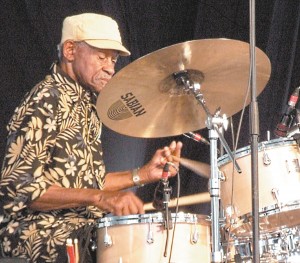Multi-talented New Orleanian Tony Bazley dies
28th December 2015 · 0 Comments
By Geraldine Wyckoff
Contributing Writer
Tony “Oulabula” Bazley was a great drummer, a talented folk artist and a gregarious man whose career and nature took him zigzagging around the world. Bazley, a New Orleans native, died in Toronto, Canada, one of his other “homes,” on Wednesday, December 16, 2015. He was 81.
Bazley found that being from New Orleans was often the key to opening important doors during his almost six-decade career. While living in Los Angeles, he was introduced as a New Orleanian to saxophone legend Eric Dolphy who was performing at the Club Oasis. “That was it,” Bazley said in a 2004 interview. “That’s where I really learned my jazz.” The drummer performed with the innovative saxophonist for a year and it was through Dolphy that Bazley met such jazz giants as drummer Max Roach and saxophonists John Coltrane and Sonny Rollins. While in Los Angeles, Bazley would go on to record with such notables as guitarist Wes Montgomery on his 1958 album Far West, vibraphonist Roy Ayers on 1963’s West Coast Vibes and on saxophonist Teddy Edwards’ and keyboardist Les McCann’s 1959 release, It’s About Time. During this period the drummer also had the opportunity to perform with saxophonist Dexter Gordon, bassist Leroy Vinnegar and spent eight years drumming with reedman William Green’s organ combo.
Bazley’s interest in music began while growing up in New Orleans. “Every neighborhood had a bar and a band,” he once remembered. At age 13 he and some neighborhood friends put a little rhythm and blues group together. Oddly, perhaps, what really sealed the deal of Bazley wanting to become a musician was when, as a youngster, he went to the State Palace Theater and saw a movie that featured bandleader Cab Calloway. Bazley related that his thoughts were, “Hey, I want to be dressed up that way.”
Bazley attended Booker T. Washington High School, an institution known for teeming with musical talent. He was fortunate to study music with the highly influential teacher Yvonne Bush. It was drummer Earl Palmer who first brought the young Bazley to the legendary Dew Drop Inn and encouraged him to sit in with the band.
In 1952, Bazley joined the U.S. Air Force and performed with the Special Services Band. Based in Sacramento, California, Bazley recalled that he played a gig the very night after he was discharged. That was the beginning of what could be described as Bazley’s West Coast era.
It wasn’t until 1989 that Bazley returned to his hometown. Though, as he told it, it wasn’t exactly voluntary – his mother went to California and retrieved him. “I was a little off track,” he confessed. Thereafter he cared for his elderly mother and started gigging around town. Bazley led his own band and could be heard on jazz sets with the likes of saxophonist Earl Turbinton and pianists Ed Frank and Ellis Marsalis.
It was when Bazley was playing with Ellis Marsalis that trombonist Delfeayo Marsalis first heard the drummer. After that, Bazley would come by Delfeayo’s gig (probably at the Funky Butt) and ask to sit in with the band. The drummer then played with the trombonist’s group for several months of gigs.
“His playing was similar to his personality,” Delfeayo says. “He was laid back and cool but he had a very positive spirit. So when he played, he played with a good groove. That’s the main reason why I liked playing with him. He was very supportive which is very important for someone playing the drum chair. He was a good spirit.”
Bazley often gifted people with his artwork and gave Delfeayo a portrait that he created of him. It was done in pen and ink and water color as were most of the artist’s works. Even when Bazley retired as a musician, he continued to create his artwork. He was often seen with sketchbook in hand and enjoyed engaging people in conversation.
The drummer played in styles other than modern jazz and worked with such artists as saxophonist David Lastie and even on the street with clarinetist Doreen Ketchens.
In 1995, Bazley made his first of several jumps to Europe skipping from country to country as he got tired of a scene. He said that saying he was from New Orleans was “like magic” over there.
Bazley also made frequent sojourns to Canada. He’d often leave New Orleans soon after Jazz Fest and spend his summers there.
At the 2008 New Orleans Jazz & Heritage Festival – perhaps his last appearance at the event – Bazley was in his element. The drummer led a group with trumpeter Nicholas Payton, saxophonist Roderick Paulin, bassist Chris Severin and pianist Richard Knox for a set of hard-swinging, pure, no-frills bebop.
“I consider myself a bebop drummer,” Bazley once accurately noted. “In Europe they call me the gumbo drummer – like gumbo, it’s a concoction.”
At press time, funeral arrangements were still pending.
This article originally published in the December 28, 2015 print edition of The Louisiana Weekly newspaper.




